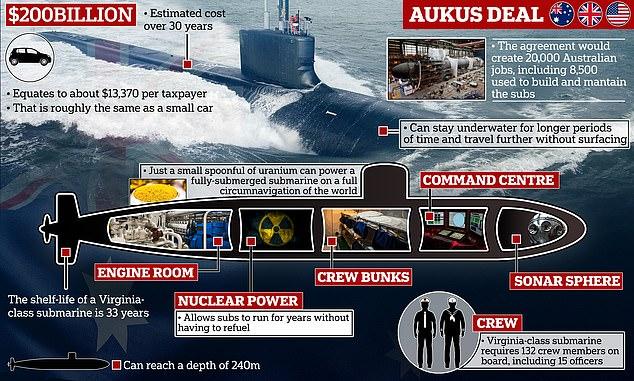The United Kingdom and Australia have strengthened their strategic partnership by signing a landmark 50-year treaty to deepen collaboration under the AUKUS submarine pact, Reuters reports. This long-term agreement marks a significant step in bolstering security and defense cooperation between the two nations amid increasing geopolitical tensions in the Indo-Pacific region. The treaty underscores a shared commitment to advancing cutting-edge submarine capabilities, enhancing maritime stability, and countering emerging threats alongside the United States, the third partner in the trilateral AUKUS alliance.
UK and Australia Strengthen Strategic Ties with Long-Term Submarine Agreement
In a decisive move signaling enhanced collaboration, the United Kingdom and Australia have inked a groundbreaking submarine accord that will span the next 50 years. This long-term treaty is set to significantly boost naval capabilities and foster mutual trust between the two nations under the broader AUKUS framework. At the heart of this pact lies a commitment to jointly develop and maintain a state-of-the-art fleet of nuclear-powered submarines, designed to ensure regional stability and safeguard maritime security in the Indo-Pacific. Analysts emphasize that this agreement reinforces both countries’ strategic interests amid evolving geopolitical challenges, as well as their shared vision of a rules-based international order.
Key elements of this submarine deal include:
- Joint research and development: Advanced stealth technology and propulsion systems.
- Long-term infrastructure investment: Upgrades to Australian naval shipyards and training facilities.
- Interoperability initiatives: Enhanced coordination between British and Australian naval forces.
- Security assurances: Strengthened intelligence sharing and defense cooperation.
| Aspect | UK Contribution | Australia Contribution |
|---|---|---|
| Submarine Design | Nuclear propulsion expertise | Modular construction capabilities |
| Training | Operational experience | Local naval academies |
| Infrastructure | Technical oversight | Shipyard modernization |
Implications of the 50-Year AUKUS Treaty for Regional Security and Defense Capabilities
The 50-year AUKUS submarine treaty signals a significant shift in the Indo-Pacific security landscape, underpinning a long-term strategic partnership between the UK, Australia, and the United States. This extended commitment not only enhances Australia’s defense capabilities but also acts as a deterrent amidst increasing regional tensions. By securing advanced nuclear-powered submarine technology, Australia is set to elevate its maritime dominance, fostering greater stability and balance in a region marked by competing naval ambitions.
Key implications of the treaty include:
- Enhanced defense interoperability: Streamlined collaboration between allied naval forces through shared technology and joint training programs.
- Strategic deterrence: Bolstering presence to counterbalance rising influence from rival powers in the Indo-Pacific.
- Technological innovation: Accelerated development and deployment of cutting-edge submarine capabilities.
- Regional stability: Encouragement of stronger defense ties with neighboring countries, reinforcing broader security coalitions.
| Aspect | Pre-Treaty Status | Post-Treaty Outlook |
|---|---|---|
| Submarine Fleet | Conventional diesel-electric | Nuclear-powered, longer endurance |
| Allied Coordination | Limited joint exercises | Integrated training and operations |
| Regional Influence | Moderate naval presence | Enhanced power projection |
Experts Recommend Enhanced Collaboration to Maximize Benefits of the Submarine Pact
Leading defense analysts highlight that the success of the extended submarine agreement hinges on a robust framework for strategic and operational cooperation between the UK and Australia. By leveraging shared technological expertise and intelligence capabilities, both nations can accelerate the development and deployment of next-generation submarines while enhancing maritime security in the Indo-Pacific region. Experts emphasize that integrated training programs, joint exercises, and data-sharing protocols are vital components to fully realize the pact’s potential benefits over the next five decades.
Furthermore, specialists advocate for transparent communication channels and synchronized research and development initiatives to prevent duplication of efforts and optimize resource allocation. In a recently published analysis, defense strategists outlined the key pillars necessary for productive collaboration:
- Multinational innovation labs focusing on stealth and propulsion technologies
- Shared maintenance and logistics hubs to streamline operational readiness
- Coordinated policy frameworks to align regulatory standards and export controls
| Collaboration Focus | Expected Outcome | Timeline |
|---|---|---|
| Joint Technology Development | Enhanced stealth capabilities | 5-10 years |
| Personnel Exchange Programs | Interoperability & skills transfer | Immediate – ongoing |
| Integrated Command Systems | Improved operational coordination | 3-7 years |
Future Outlook
The deepening of the AUKUS submarine pact through a landmark 50-year treaty marks a significant milestone in the strategic partnership between the UK and Australia. As both nations strengthen their naval capabilities amid evolving geopolitical challenges, this long-term commitment underscores their shared interests in regional security and defense cooperation. Observers will be watching closely to see how this enhanced alliance influences the broader Indo-Pacific balance of power in the years ahead.




